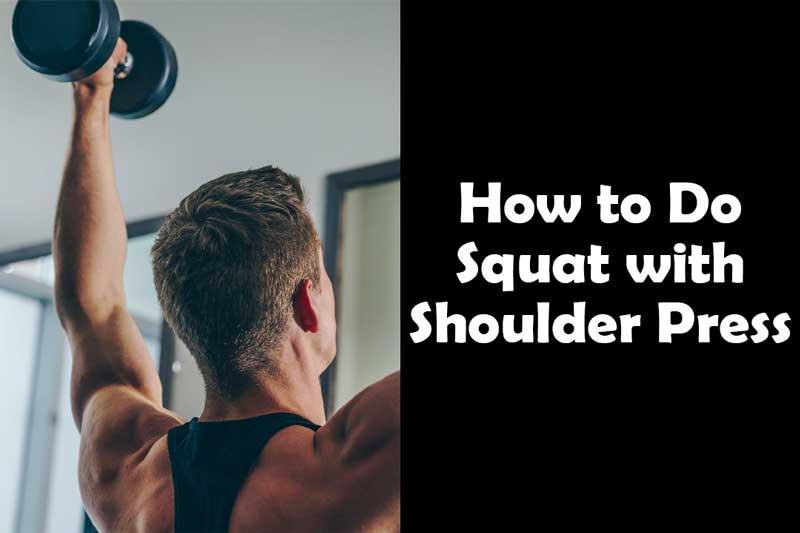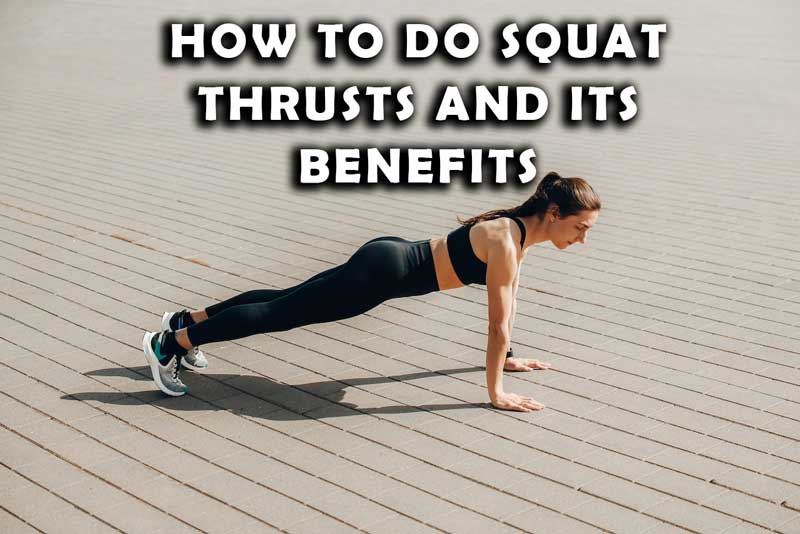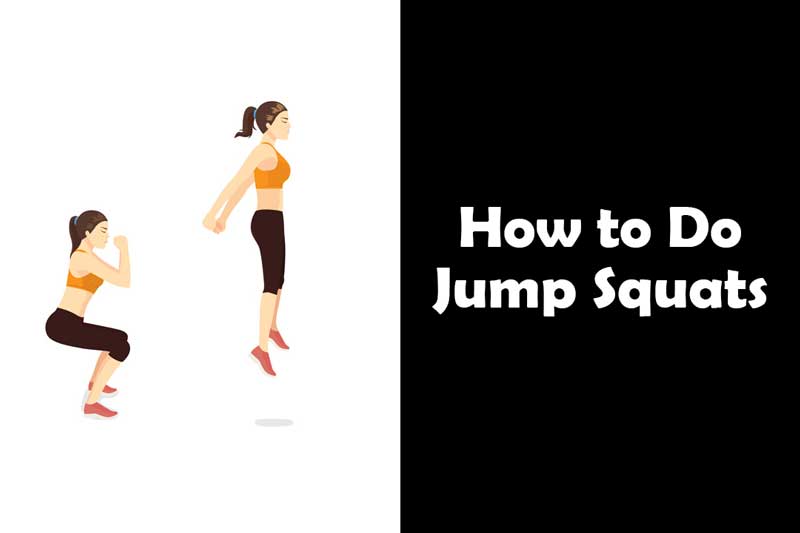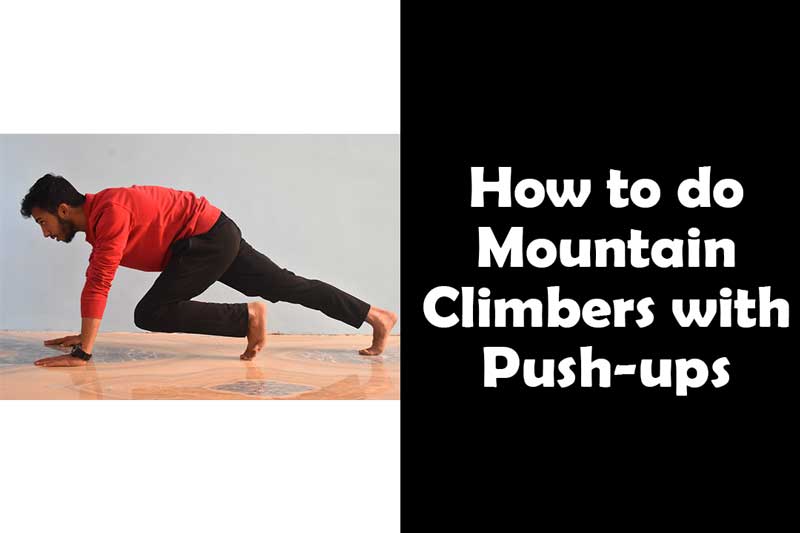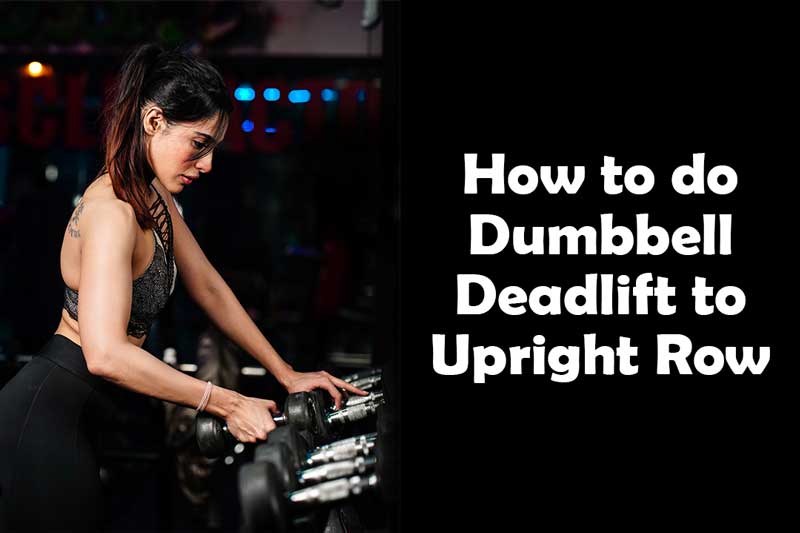Are you looking to incorporate a full-body exercise into your workout routine? Look no further than the squat with shoulder press. This compound movement targets multiple muscle groups simultaneously, making it an efficient and effective exercise for building strength and improving overall fitness.
In this article, we will guide you step by step on how to perform the squat with shoulder press correctly, providing valuable tips to maximize your results. Let’s dive in!
What is Squat with Shoulder Press?
To know about squats with shoulder press in detail, first let us see the 2 different exercises that make this exercise. The 2 exercises are 1) squat and 2) Shoulder press.
1) The Squat
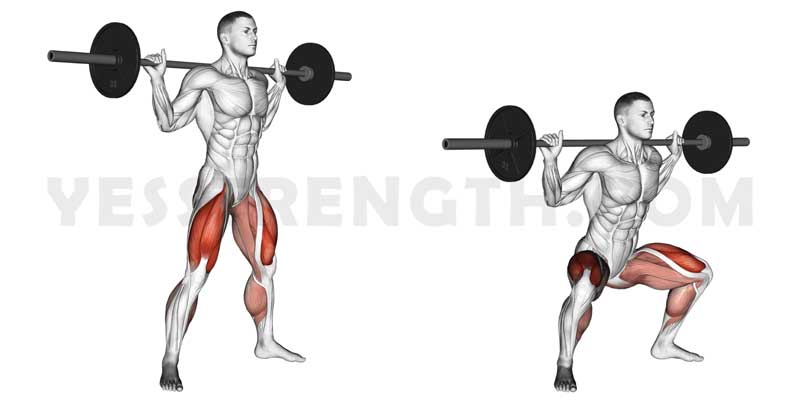
A squat is a type of exercise that primarily targets the muscles of the lower body, particularly the quadriceps, hamstrings, and glutes. It is a fundamental movement that involves bending the knees and hips while keeping the torso upright, typically either with bodyweight or with a weighted barbell resting on the shoulders.
2) The Shoulder Press
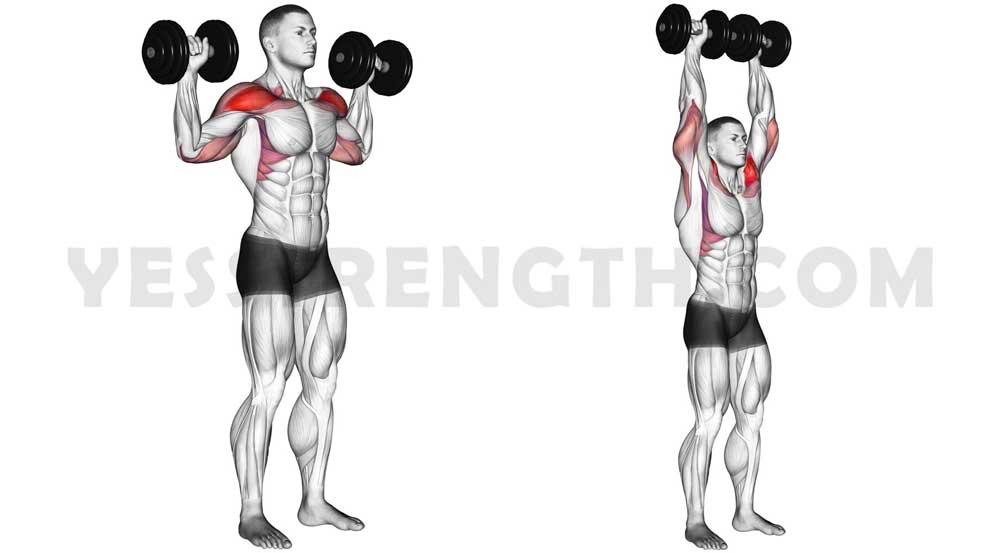
Shoulder press, also known as overhead press or military press, is an exercise that primarily targets the muscles of the shoulders and upper arms. It involves pressing a weight, typically a barbell or dumbbells, overhead from a starting position at shoulder level.
The Squat with Shoulder Press
The squat with shoulder press is a dynamic compound exercise that combines the lower body strength-building benefits of squats with the upper body engagement of shoulder presses. It targets the quadriceps, glutes, hamstrings, shoulders, and core muscles, providing a comprehensive workout for your entire body.
Benefits of Squat with Shoulder Press
The squats with shoulder press offers numerous benefits, including:
1) Full-Body Workout
The squat with shoulder press is a compound exercise that engages both the lower body and upper body simultaneously.
By incorporating this exercise into your routine, you can efficiently work multiple muscle groups at once, saving time and maximizing your workout efficiency.
2) Strength Building
This exercise is highly effective for building overall strength. The squat component targets the lower body muscles, including the quadriceps, glutes, and hamstrings, while the shoulder press works the deltoids and other upper body muscles.
By challenging multiple muscle groups with resistance, you can promote muscle growth, enhance muscular endurance, and increase overall strength.
3) Improved Functional Movement
This full body exercise mimics natural movements like lifting objects, making it highly beneficial for improving functional fitness.
By training your muscles to work together in a coordinated manner, you can enhance your ability to perform everyday activities with ease and efficiency.
4) Increased Calorie Burn
As a compound movement that engages multiple large muscle groups, this amazin exercise can elevate your heart rate and increase calorie expenditure.
This makes it an effective exercise for burning calories and aiding in weight management or fat loss goals.
5) Enhanced Core Stability
Proper execution of the squats with shoulder press requires core stability and engagement. Your core muscles, including the abdominals, obliques, and lower back muscles, play a crucial role in maintaining a stable posture throughout the exercise.
By regularly performing this exercise, you can strengthen and stabilize your core, improving overall balance, posture, and functional movement patterns.
6) Time Efficiency
Incorporating compound exercises like the squat with shoulder press into your workouts allows you to target multiple muscle groups with just one exercise.
This can help streamline your training sessions and make the most of your time in the gym.
7) Progressive Overload
The squats with shoulder press is easily customizable to accommodate different fitness levels. You can adjust the weight, repetitions, and sets to progressively challenge yourself as you become stronger and more proficient in the exercise. This allows for ongoing progression and prevents plateauing in your fitness journey.
8) Mind-Muscle Connection
Performing the squat with shoulder press requires focus and coordination between various muscle groups.
By developing a strong mind-muscle connection, you can enhance your body awareness, improve movement efficiency, and optimize your overall training experience.
Squat with Shoulder Press Muscles Worked
We already know that this exercise is a compound exercise that engages multiple muscle groups simultaneously, providing a comprehensive full-body workout. Here are the primary muscles worked during this exercise:
1) Quadriceps
The squat motion targets the quadriceps muscles located on the front of your thighs. These muscles help extend your knees and are crucial for lower body strength and stability.
2) Glutes
As you squat down and then rise back up, the gluteal muscles, including the gluteus maximus, medius, and minimus, are activated. These muscles are responsible for hip extension and contribute to overall lower body power and strength.
3) Hamstrings
The hamstrings, located on the back of your thighs, play a significant role in the squats with shoulder press exercise. They work synergistically with the glutes to extend the hips during the squatting phase.
4) Deltoids
The deltoid muscles, which are situated in the shoulders, are engaged during the shoulder press portion of the exercise. They are responsible for raising the arms and lifting the dumbbells overhead.
5) Trapezius
The upper and middle fibers of the trapezius muscles, located in the upper back and neck area, assist in stabilizing the shoulders and upper body during the shoulder press movement.
6) Core Muscles
The squat with shoulder press requires core stabilization throughout the exercise. The muscles of the core, including the rectus abdominis, transverse abdominis, and obliques, work together to maintain proper posture and stability during the movement.
Proper Form and Technique
Maintaining proper form and technique is crucial to prevent injury and achieve optimal results. Here’s how to perform the squat with shoulder press with correct form:
- Stand with your feet shoulder-width apart and hold dumbbells in each hand, resting them on your shoulders. You can also use barbell if you have already done this exercise and have expeience.
- Lower your body into a squat position by bending your knees and hips, keeping your back straight and chest up. Aim to bring your thighs parallel to the ground.
- As you rise from the squat, extend your legs while simultaneously pressing the dumbbells overhead, fully extending your arms.
- Lower the dumbbells back to your shoulders as you descend into the next squat repetition.
- Repeat the movement for the desired number of repetitions.
Step-by-Step Guide
Let’s break down this full body exercise into a step-by-step guide for better understanding:
Step 1: Starting Position
- Stand with your feet shoulder-width apart and toes slightly turned out.
- Hold a dumbbell in each hand, resting them on your shoulders with your palms facing forward.
Step 2: Squat
- Lower your body by bending your knees and hips, as if sitting back into a chair.
- Keep your chest up, back straight, and weight on your heels.
- Aim to lower until your thighs are parallel to the ground.
Step 3: Shoulder Press
- As you rise from the squat position, simultaneously press the dumbbells overhead by extending your arms.
- Fully extend your arms without locking your elbows.
- Keep your core engaged and maintain stability throughout the movement.
Step 4: Return to Starting Position
- Lower the dumbbells back to your shoulders as you descend into the next squat repetition.
- Repeat the squat with shoulder press movement for the desired number of repetitions.
You might also like:
How to do dumbbell deadlift to upright row?
Common Mistakes to Avoid
To ensure you perform the squats with shoulder press correctly and safely, be mindful of these common mistakes:
- Improper squat depth: Failing to reach parallel or going too deep can strain your knees and compromise your form. Aim to squat until your thighs are parallel to the ground.
- Lack of core engagement: Neglecting to engage your core muscles can lead to instability and potential injury. So, keep your core tight throughout the exercise.
- Overarching or rounding of the back: Maintain a neutral spine throughout the movement to avoid unnecessary strain on your lower back.
- Using excessive weight: Start with lighter weights to master the proper form before progressing to heavier loads. Using weights beyond your capacity can lead to injury.
- Neglecting proper breathing: Breathe in as you lower into the squat and exhale as you press the dumbbells overhead. Maintain a consistent breathing pattern throughout the exercise.
Variations and Modifications
Here are a few variations and modifications to consider for the squat with shoulder press exercise:
- Goblet squat with shoulder press: Instead of using dumbbells, hold a kettlebell close to your chest during the squat and shoulder press movement.
- Resistance band squat with shoulder press: Attach resistance bands to an anchor point above you and hold the ends of the bands in each hand while performing the exercise.
- Medicine ball squat with shoulder press: Hold a medicine ball close to your chest throughout the movement to add an extra challenge.
Incorporating Squat with Shoulder Press into Your Routine
To reap the maximum benefits of the squat with shoulder press, consider the following recommendations for incorporating it into your workout routine:
- Include the exercise in your full-body strength training sessions, while aiming for 2-3 sets of 8-12 repetitions.
- Perform the squat with shoulder press exercise 2-3 times per week, allowing for adequate rest and recovery between sessions.
- Combine it with other compound exercises like lunges, deadlifts, or bent-over rows to create a well-rounded workout.
Safety Precautions
To ensure your safety while performing the squat with shoulder press, keep the following precautions in mind:
- Consult with a healthcare professional before starting any new exercise program, especially if you have pre-existing medical conditions or injuries.
- Warm up adequately before performing the exercise to prepare your muscles for the movement.
- Start with lighter weights and gradually increase the load as you become comfortable with the exercise.
- Listen to your body and avoid pushing through pain or discomfort. Also, modify or stop the exercise if necessary.
Workout Tips for Beginners
If you’re new to the squat with shoulder press exercise, consider the following tips to ease into the movement:
- Begin with bodyweight squats to establish proper squat form before adding the shoulder press component.
- Practice the movement without weights initially to focus on technique and stability.
- Gradually introduce dumbbells or other equipment as you gain confidence and strength.
Conclusion
The squat with shoulder press is a highly effective compound exercise that targets multiple muscle groups, providing a comprehensive full-body workout. By following the proper form and technique outlined in this guide, you can maximize your results and reduce the risk of injury. So, incorporate this exercise into your routine and enjoy the strength, stability, and functional benefits it offers.
FAQs
1) Can I perform the squat with shoulder press without weights?
Yes, you can start with bodyweight squats and do an empty hand shoulder press. As you progress you can use weights as you build strength and confidence.
2) What muscles does the squat with shoulder press target?
This exercise primarily targets the quadriceps, glutes, hamstrings, shoulders, and core muscles.
3) Is the squat with shoulder press suitable for beginners?
Yes, beginners can perform this exercise by starting with lighter weights and focusing on proper form and technique.
4) Can I perform the squat with shoulder press if I have knee issues?
If you have knee issues, it’s important to consult with a healthcare professional before attempting this exercise. They can provide guidance on modifications or alternative exercises that suit your needs.
5) How many calories does the squat with shoulder press burn?
The number of calories burned during the squat with shoulder press depends on various factors such as body weight, intensity, and duration of the exercise. It is considered a calorie-burning exercise due to its compound nature.

